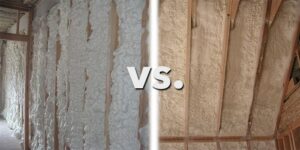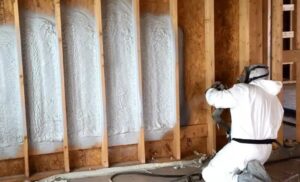Insulation is a central factor in controlling energy costs, indoor comfort, and long-term building durability. Homeowners and property managers often face the choice between open-cell spray foam insulation and closed-cell spray foam insulation. While both improve efficiency, their performance characteristics differ in cost, moisture resistance, and structural impact. This guide provides a complete comparison to help residents and commercial property owners make informed decisions.
Open-Cell and Closed-Cell Insulation: Core Differences Explained
The two spray foam options may look similar, but their physical properties create very different results. Understanding density, expansion, and performance helps in selecting the right type for specific conditions.
What Is Open-Cell Spray Foam?
Open-cell spray foam is a lightweight insulation that expands significantly during installation. It creates an air barrier while remaining flexible, which makes it effective in hard-to-reach areas. Its lower density makes it less expensive but also less resistant to moisture.
What Is Closed-Cell Spray Foam?
Closed-cell spray foam is dense and rigid, offering high thermal resistance and structural reinforcement. It expands less during application but forms a durable moisture barrier. Its strength makes it suitable for basements, crawlspaces, and exterior applications where water protection is critical.
Insulation Performance and R-Value Comparison
R-value measures how well insulation resists heat transfer. Higher R-values mean better performance, but context matters depending on the home’s location and building design.
R-Value of Open-Cell Insulation
Open-cell spray foam typically has an R-value of about 3.5 to 4 per inch. It is effective in moderate climates and for interior walls where sound control is important.
R-Value of Closed-Cell Insulation
Closed-cell spray foam delivers a much higher R-value, ranging from 6 to 7 per inch. This makes it ideal for areas requiring maximum energy efficiency or where space for insulation is limited.
Side-by-Side R-Value Comparison
| Insulation Type | Typical R-Value (per inch) | Best Application Areas |
|---|---|---|
| Open-Cell Spray Foam | 3.5 – 4.0 | Interior walls, soundproofing, attics |
| Closed-Cell Spray Foam | 6.0 – 7.0 | Basements, crawlspaces, exterior walls |
Moisture Resistance and Air Sealing
Moisture protection is a major factor in insulation choice, particularly for crawlspaces, basements, and regions with high humidity.
Moisture Performance of Open-Cell Insulation
Open-cell foam is vapor permeable. While it allows walls to “breathe,” it can absorb water and lose performance when exposed to damp conditions. It is not recommended in flood-prone or consistently humid areas.
Moisture Performance of Closed-Cell Insulation
Closed-cell foam resists water and acts as a vapor barrier. This makes it well-suited for below-grade walls, crawlspaces, and roofs where moisture infiltration poses structural risks.
Structural Strength and Durability
Insulation can contribute more than energy efficiency; in some cases, it reinforces the building structure itself.
How Open-Cell Foam Affects Structures
Because of its low density, open-cell foam does not add measurable structural strength. It works best in interior applications where reinforcement is not required.
How Closed-Cell Foam Reinforces Buildings
Closed-cell spray foam adds rigidity to walls and increases structural integrity. It bonds tightly to surfaces and resists compression, extending the lifespan of walls and roofs.
Sound Control and Acoustic Performance
Noise reduction is a priority for many homeowners, particularly in urban areas or multi-unit buildings.
Acoustic Benefits of Open-Cell Insulation
Open-cell foam is highly effective at absorbing sound waves, making it a strong choice for interior walls, media rooms, and bedrooms.
Acoustic Benefits of Closed-Cell Insulation
Closed-cell foam is less effective at sound absorption due to its rigid, dense structure. While it blocks air leaks, it does not provide the same level of sound dampening.
Cost Considerations: Initial vs. Long-Term
Choosing insulation involves balancing upfront investment with long-term performance savings.
Cost Profile of Open-Cell Insulation
Open-cell foam is more affordable, both in material and installation costs. Its lower density requires less material, which reduces price. However, it may not deliver the same durability or efficiency as closed-cell foam in high-demand applications.
Cost Profile of Closed-Cell Insulation
Closed-cell foam has higher installation costs but provides long-term energy savings. Its durability reduces the need for replacement or maintenance, which can offset the upfront expense.
Best Applications for Each Insulation Type
Each insulation type has environments where it performs best. Correct placement maximizes energy savings and durability.
Where Open-Cell Foam Works Best
- Attics and roof decks in dry climates
- Interior walls needing sound control
- Areas where budget limits higher-cost insulation
Where Closed-Cell Foam Works Best
- Basements and crawlspaces with moisture risks
- Exterior walls exposed to weather
- Small spaces where maximum R-value is required
Conclusion
The choice between open-cell and closed-cell insulation depends on project goals, climate, and budget. Open-cell foam is lighter, more affordable, and ideal for sound control in dry conditions. Closed-cell foam delivers superior moisture resistance, higher R-values, and structural reinforcement, making it the better option for demanding environments.
For property owners, the decision should weigh immediate installation costs against the long-term value of durability and efficiency. Closed-cell insulation often outperforms in challenging conditions, while open-cell spray foam insulation remains an effective and economical option for interior applications.
FAQs
What is the main difference between open-cell and closed-cell spray foam?
The main difference lies in density and structure. Open-cell is lighter and more flexible, while closed-cell is dense, rigid, and provides higher thermal resistance.
Which insulation type is better for basements?
Closed-cell spray foam is recommended for basements because it resists moisture and strengthens structural walls, preventing long-term dampness issues.
Does open-cell spray foam provide moisture protection?
No, open-cell foam is vapor permeable and can absorb moisture. It should not be used in areas with consistent humidity or water exposure.
Which insulation type helps with soundproofing?
Open-cell spray foam is more effective for sound absorption, making it a good choice for interior walls and rooms where noise control is a priority.
Can closed-cell spray foam improve energy efficiency?
Yes, closed-cell foam has one of the highest R-values among insulation materials, reducing energy loss and lowering heating and cooling costs.
Reviewer: Sophia White has 8 years of experience in spray foam insulation. She reviewed this post and gave clear guidance on aligning business messaging with what customers actually care about.

